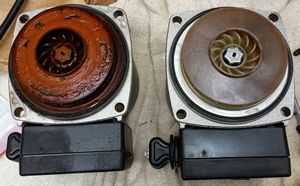WHAT IS CORROSION INHIBITOR?
Corrosion inhibitor is a chemical added to heating systems to help prevent the formation
of black sludge in the boiler, radiators and pipework.
WHAT CAUSES CORROSION?
The main components of central heating boilers and radiators have traditionally been
iron and steel
As a result, corrosion is quite common in your heating system's iron and steel components
as they are in day-to-day contact with water and oxygen, causing rusting on the inside.
This happens particularly when the system water becomes too acidic (a normal event
in heating system water, especially when the pH level of
the local water is naturally low).
Copper pipework doesn't normally suffer from the same form of corrosion, but it will
suffer from a build-up of the black sludge caused
by corrosion, which can then block pipes.
Radiators and pipes in the lowest parts of the heating system are particularly prone
to black sludge. This is because black
sludge is heavier than water and so tends sinks to the bottom of the system.
WHAT PREVENTS CORROSION?
To prevent corrosion and limescale in heating systems a chemical compound is added
which stops the water from becoming too acidic.
The compound is chemically formulated to stabilise the water in the heating system
at the neutral pH value of 7 and bond a protective coating to iron and steel;
this makes corrosion less likely in iron and steel components.
HOW DO I ADD CORROSION INHIBITOR?
Before adding corrosion inhibitor for the first time it is advisable to flush out
any existing contaminated water and black sludge,
preferably with a powerflush.
|
EFFECT OF CORROSION ON
CENTRAL HEATING PUMP
 OLD PUMP WITH CORROSION &
OLD PUMP WITH CORROSION &
LIMESCALE VS NEW PUMP
As the system is refilled the inhibitor is added as part of the fresh water, typically
in a mixture of around 1 litre of inhibitor to every 100 litres of system water, depending
on the chemical make-up of the concentrate or brand of inhibitor used.
1 litre of inhibitor will typically treat a boiler and 10 radiators, though brands
may differ in coverage.
Assuming the inhibitor is added to a clean system, protection typically lasts for
2-3 years, after which the inhibitor should be topped-up by draining off some water
and refilling with a further dose of inhibitor.
On an open vent system the water supply to the feed and expansion tank is turned off
and the inhibitor is added to the tank.
Water is then drained from the system and, as the water level drops in the expansion
tank, the water supply is turned on again to allow the tank to refill until enough
fresh water has been added to ensure that the inhibitor has entered the system properly.
In a sealed system, e.g. with a combination boiler, inhibitor is typically added by
isolating a radiator, draining out water and introducing inhibitor through the bleed
valve opening.
The radiator is then refilled with fresh water through the filling loop and the system
is re-pressurised. |